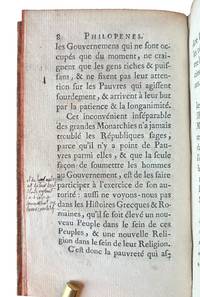Philopenes, ou du Régime des Pauvres
- SIGNED
- Paris: chez Regnard, Pankouke & Duchesne, 1764
Paris: chez Regnard, Pankouke & Duchesne, 1764. 12mo (165 x 97 mm). [1] leaf, 113 pp. Title with engraved vignette containing the author’s arms, by Charles-Etienne Gaucher. (Small stain to fore-edges of 7 leaves, light foxing at beginning and end.) 18th-century calf-backed pastepaper-covered boards, smooth spine gold-tooled in compartments with fleurons and small star tools, red morocco gilt lettering piece, edges stained red (restorations to joints, spine, and rear endpapers). Provenance: D. V. Bréhier, signature dated 28 Jan. 1854; scattered marginal notes; later signature (illegible) dated July 1872. ***
First (only?) Edition of a plan for reducing the numbers of beggars in France. The author, a marquis from the Orléanais, was an enthusiastic and somewhat importunate follower of Jean-Jacques Rousseau. He states bluntly at the outset that “to have fewer poor people in the Realm, one needs to get rid of the rich” (p. 4), but since that is not possible, the goal should be to improve the lives of the poor and reduce the need that drives people to beg. His plan for the abolition of “vagabonds,” i.e., the homeless, rests on a distinction between the virtuous working poor, or those who cannot work because of age or infirmity, and those fictive masses who supposedly choose to beg out of pure perverse laziness (plus ça change...).
The work begins with a historical review of French anti-poverty laws and regulations, which attempted to restrict vagabondage by making local secular and/or ecclesiastical authorities responsible for providing alms, restricting the movement of the poor, and punishing not only the destitute but also unauthorized individuals who provided charity. Séguier transcribes in full the most recent plan, Louis XV’s 1724 Déclaration concernant les Mendians & Vagabonds (not enacted), which proposed a system of realm-wide control of the poor relying heavily on incarceration in poorhouses or “hospitals,” run by nuns. Punishments for repeated transgressions included whipping, prison, and the galleys.
Declaring that these traditional punitive approaches were cruel as well as useless, since the numbers of beggars continued to grow, and eloquently describing the inhumane institutional ugliness of the hôpitaux, Séguier de Saint-Brisson proposes the establishment of temporary shelters or hospices, open to those traveling to seek work, or those who had to come to Paris for administrative matters. These individuals would be allowed to stay for a limited time, with free room and board, and freedom of movement. Although this system still required internal passports and state control over people’s movements, it recognized the psychological need for autonomy and represented a more humane solution to the perpetual problem of homelessness and begging. Séguier does not address the issue of noncooperation, avoiding the question of punishments altogether.
Séguier explains that he dares publish his thoughts because a commission has just been formed to try to address these issues. That commission, set up in 1764 by the new controller-general of finances, Clément Charles François de Laverdy, ignored his proposed reforms and simply created a new, equally unsuccessful incarnation of the old lock ‘em up approach, involving a system of 88 “dépots de mendicité,” which were “somewhere between a workhouse and a prison” (Hickey, Local hospitals in Ancien Régime France, p. xv).
I locate one copy in the US (U. Minnesota). It is not clear to me whether the very rare Lettre à Philopenes, ou, Réflexions sur le régime des pauvres, published anonymously later the same year, is indeed a different edition of this work, as implied by library cataloguers, or is instead (more likely) a reply to it.
Camille Granier, Essai de bibliographie charitable (1891), no. 1325: this is the earliest of 127 entries in the section of general proposals to address begging (“Mendicité: Mesures générales et projets”), listed chronologically to 1883. Cf. Portalis, Les Graveurs du 18eme siecle (1881), vol. 2 Gaucher no. 276, p. 291, for the title engraving.
First (only?) Edition of a plan for reducing the numbers of beggars in France. The author, a marquis from the Orléanais, was an enthusiastic and somewhat importunate follower of Jean-Jacques Rousseau. He states bluntly at the outset that “to have fewer poor people in the Realm, one needs to get rid of the rich” (p. 4), but since that is not possible, the goal should be to improve the lives of the poor and reduce the need that drives people to beg. His plan for the abolition of “vagabonds,” i.e., the homeless, rests on a distinction between the virtuous working poor, or those who cannot work because of age or infirmity, and those fictive masses who supposedly choose to beg out of pure perverse laziness (plus ça change...).
The work begins with a historical review of French anti-poverty laws and regulations, which attempted to restrict vagabondage by making local secular and/or ecclesiastical authorities responsible for providing alms, restricting the movement of the poor, and punishing not only the destitute but also unauthorized individuals who provided charity. Séguier transcribes in full the most recent plan, Louis XV’s 1724 Déclaration concernant les Mendians & Vagabonds (not enacted), which proposed a system of realm-wide control of the poor relying heavily on incarceration in poorhouses or “hospitals,” run by nuns. Punishments for repeated transgressions included whipping, prison, and the galleys.
Declaring that these traditional punitive approaches were cruel as well as useless, since the numbers of beggars continued to grow, and eloquently describing the inhumane institutional ugliness of the hôpitaux, Séguier de Saint-Brisson proposes the establishment of temporary shelters or hospices, open to those traveling to seek work, or those who had to come to Paris for administrative matters. These individuals would be allowed to stay for a limited time, with free room and board, and freedom of movement. Although this system still required internal passports and state control over people’s movements, it recognized the psychological need for autonomy and represented a more humane solution to the perpetual problem of homelessness and begging. Séguier does not address the issue of noncooperation, avoiding the question of punishments altogether.
Séguier explains that he dares publish his thoughts because a commission has just been formed to try to address these issues. That commission, set up in 1764 by the new controller-general of finances, Clément Charles François de Laverdy, ignored his proposed reforms and simply created a new, equally unsuccessful incarnation of the old lock ‘em up approach, involving a system of 88 “dépots de mendicité,” which were “somewhere between a workhouse and a prison” (Hickey, Local hospitals in Ancien Régime France, p. xv).
I locate one copy in the US (U. Minnesota). It is not clear to me whether the very rare Lettre à Philopenes, ou, Réflexions sur le régime des pauvres, published anonymously later the same year, is indeed a different edition of this work, as implied by library cataloguers, or is instead (more likely) a reply to it.
Camille Granier, Essai de bibliographie charitable (1891), no. 1325: this is the earliest of 127 entries in the section of general proposals to address begging (“Mendicité: Mesures générales et projets”), listed chronologically to 1883. Cf. Portalis, Les Graveurs du 18eme siecle (1881), vol. 2 Gaucher no. 276, p. 291, for the title engraving.





